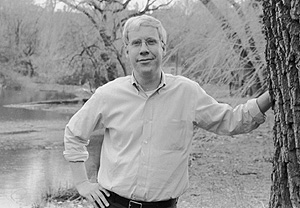 |
|
||
|
|||
Of
nature and man
BU
hosts international ecocriticism conference
By David J. Craig
|
|
|
| Adam Sweeting Photo by Kalman Zabarsky |
|
New Englanders might be surprised to learn that Adam Sweeting’s
forthcoming book Beneath the Second Sun: A Cultural History of Indian
Summer is the first lengthy treatise on the symbolic use in American
literature of that mysterious autumnal weather phenomenon.
Sweeting, a
CGS associate professor of humanities and rhetoric, who is among a new
group of environmentally conscious cultural critics, or ecocritics,
says it is not really that surprising. Scholars of art and literature,
he says, have traditionally contemplated the natural world merely as
a setting, as a scenic backdrop against which important themes in art
unfold. Sweeting and fellow ecocritics, in contrast, place the natural
world at the center of the action: Beneath the Second Sun (University
of New Hampshire Art Gallery, 2003) not only traces references to Indian
summer in 19th-century American literature and painting, but it explores
how artists like Henry David Thoreau and Emily Dickinson experienced
and were inspired by the weather, and even explains the science behind
it.
From June 3 to 7, Sweeting will host the most important figures in
ecocriticism at BU for the fifth biennial conference of their flagship
professional
organization, the Association for the Study of Literature and Environment
(ASLE). Featured speakers will include Leo Marx, an MIT professor emeritus,
who is a primary architect of the field of American studies, Lawrence
Buell, chairman of the Harvard English department and an authority on
Thoreau, Edward O. Wilson, an internationally renowned Harvard entomologist
and two-time Pulitzer prize–winning author, and Grace Paley, the
critically acclaimed author of the short story collections Enormous
Changes at the Last Minute and Later the Same Day. About
500 scholars from 15 nations are expected to participate.
The interdisciplinary
conference will include eight plenary sessions,
as well as dozens of roundtable discussions and professional workshops
on topics such as the future direction of nature writing, writing about
urban environments, ecocriticism and Native American literature, environmental
approaches to American studies, globalization and environmental justice,
ecocritical theory, teaching environmental studies in high school, and
understanding the legacy of slavery on the American landscape.
The events
should be of particular interest to scholars and students of environmental
studies, English, and American studies, Sweeting says,
but he and fellow conference organizers have made a conscious effort
to attract hard scientists as well. “One of the goals of ecocriticism
is to break down barriers between the humanities and the sciences, and
in fact, ecocritics tend to have a fairly firm grasp of evolutionary
and other scientific processes,” he says. “We want to have
a broad spectrum of people at our conference because as a scholar that
helps you get out of the little bubble of your own specialty. It’s
easy to forget that there are people talking about the same issues you’re
interested in but coming at it from different angles, from completely
different fields.”
Nature in peril
Ecocriticism, which took root largely
among literary critics and American studies scholars in the mid-1990s,
is not a new critical theory so
much as an ethical and moral academic approach: ecocritics are united
by the conviction that nature is in peril and that they can effect
change by describing the physical environment’s role in art.
In the introduction to The Ecocriticism Reader (University
of Georgia Press, 1996), an anthology that helped define the young
field, editor
Cheryll Glotfelty, an English professor at the University of Nevada–Reno,
calls upon scholars to contribute to a new type of “literary
studies in an age of environmental crisis.”
Just as questions
of gender and race “were brought to the foreground
of literary criticism in the 1970s and 1980s, for very appropriate and
justified reasons, ecocritics now argue that the earth needs to be in
that discussion,” Sweeting says. “We want to understand how
the physical environment — which can include urban settings as well
as the natural world — is fundamental to the human experience, how it
situates us politically, socially, and emotionally. We believe that if
you read an author carefully, the environment becomes an integral part
of the narrative and that you can see how it shapes characters and their
actions.”
Sweeting, whose reputation in ecocriticism was established
with his 1996 book Reading Houses and Building Books: Andrew
Jackson Downing and the
Architecture of Popular Antebellum Literature, 1835–1855,
says he was inspired to write Beneath the Second Sun upon discovering
that the modern concept of Indian summer largely was invented by 19th-century
American authors. And poring over Dickinson’s early poems and contemporaneous
Massachusetts weather records, he realized that the poet had had plenty
of help from Mother Nature in fleshing out the concept — in the
autumn of 1859, the year she devoted herself seriously to writing, the
November
sun shone down hazily on New England’s brightly colored leaves
for several days, causing temperatures to spike into the 80s.
Possibly “the
most beautiful fall of the entire century” didn’t
please Dickinson at all, Sweeting argues in his book, but it provided
her with extraordinary inspiration. “She found it a particularly
jarring time of year, I think precisely because it was such a sudden
and a sharp break in the weather,” Sweeting says. “It sort
of underscored the coming of winter for her. And all her poetry, of course,
is about sudden emotional breaks, and there are about 20 poems that while
never using the term Indian summer, clearly draw on imagery
related to what for her was this very off-putting time of year.”
For
more information about the ASLE conference or about ecocriticism, visit www.asle.umn.edu or
call Adam Sweeting at 358-0299.
![]()
25
April 2003
Boston University
Office of University Relations
